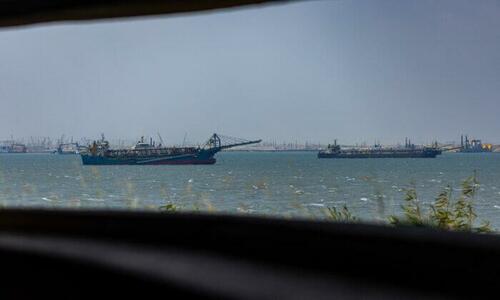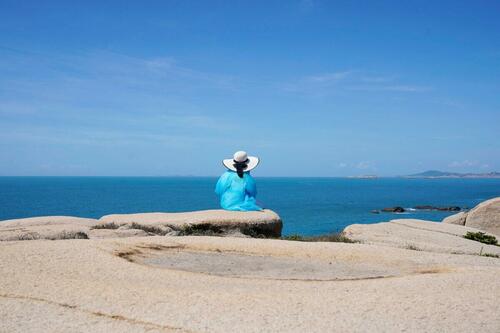
Authored by John Mac Ghlionn via The Epoch Times,
Life is a beach, they say, and we’re all just playing in the sand. Soon, though, there might not be any sand left. That’s because the world is running out of it.
Running out of sand, you ask, how can that be? After all, 33 percent of Earth is covered in desert, and many of these deserts have copious amounts of sand (not all of them, though). Yes, that’s true, but desert sand, like sea sand, lacks the compressive strength needed to construct houses, skyscrapers, roads, and bridges. In other words, when it comes to the world of construction, both desert sand and sea sand are utterly useless. This is why there is a race to secure the limited amounts of appropriate sand available.
Scarcity breeds desperation and this desperation is particularly palpable in China. The Chinese Communist Party (CCP) has deployed “pirates” to raid neighboring countries. In truth, the “pirates” have been plundering and pillaging for years. In recent times, however, they have zeroed in on Taiwan, stripping the island of its valuable deposits.
The world is experiencing a shortage of just about everything: corn, coffee, wheat, soybeans, plastic cardboard, semiconductor chips, suitably qualified workers, etc.
Now, it’s time to add sand, the most-extracted solid material in existence, to this ever-growing, highly-eclectic list. The importance of sand cannot be emphasized enough. Water is the world’s most-consumed natural resource; sand is the second most. Every construction project relies on using sand—the correct type of sand. By 2030, the construction market is expected to be worth $14.4 trillion; two years ago, it was worth $6.4 trillion. We’ll need more sand, but there might not be enough of it to go around.
Demand for sand is soaring, and this demand will likely increase dramatically over the next three to four decades. This brings us to China, a country with a voracious appetite for construction-friendly sand. In many ways, the appetite should come as little surprise; when it comes to constructing roads, bridges, and buildings, China leads the way. In an effort to satisfy its appetite, the CCP is targeting its neighbor, Taiwan.
A tourist sits facing the Taiwan Strait at the 68-nautical-mile scenic spot, one of mainland China’s closest points to Taiwan, in Pingtan Island, Fujian Province, China, on Aug. 5, 2022. (Aly Song/Reuters)
The targeting started back in 2019. In response to the CCP’s attempt to mine the island dry, Taiwan’s coastguard deployed numerous drones and water cannons to deter the invading sand miners. On that occasion, the miner retreated—but not for long. The Chinese “pirates” returned, focusing on the Taiwan-run Matsu Island, an archipelago consisting of 19 islands.
As Foreign Policy’s Elisabeth Braw reported in July 2022, “China is increasing its dredging of sand in the islands’ waters.” Such “devious activity” works to China’s advantage and leaves Taiwan with “large expenses and maritime degradation.” Susumu Takai, president of the Security Strategy Research Institute of Japan, told Braw that China lacks enough sand to continue its construction projects in various Chinese cities.
The Chinese regime doesn’t consider its activity to be illegal. Why? Because, as most readers are aware, the CCP claims Taiwan is part of China.
The CCP’s sheer greed and lack of respect also extend to other parts of Asia. Last year, as Reuters reported, dredgers were spotted off Cambodia’s Ream naval base. Not coincidentally, the dredgers happened to be operating in the very same area where Beijing happens to be funding construction projects and the development of various port facilities. In June 2022, The Washington Post ran a piece on China’s construction of a secret naval base in Cambodia. Sand, it seems, is not the only reason why China is interested in Cambodia.
Just to reiterate: China isn’t the only country scrambling to secure sand. This is a global crisis that affects the United States just as much as it affects China. Although the Chinese regime is likely to continue pillaging and acting with a high degree of impunity, there is hope for the United States.
According to Stanford geographer and environmental scientist Eric Lambin, the United States needn’t fixate too much on the mining process. “Instead of mining unconsolidated sediment deposits,” Lambin urges the government to focus on the crushing of rocks “or by recycling construction and demolition waste such as concrete or masonry.” This is because crushed rock is often considered a superior option, “thanks to better control over mineralogical composition and shape.” Whether or not Lambin’s advice is heeded remains to be seen.
In the meantime, keep an eye out for China’s sand “pirates,” whose hunger for granular deposits is likely to become even more voracious over the coming years.
Authored by John Mac Ghlionn via The Epoch Times,
Life is a beach, they say, and we’re all just playing in the sand. Soon, though, there might not be any sand left. That’s because the world is running out of it.
Running out of sand, you ask, how can that be? After all, 33 percent of Earth is covered in desert, and many of these deserts have copious amounts of sand (not all of them, though). Yes, that’s true, but desert sand, like sea sand, lacks the compressive strength needed to construct houses, skyscrapers, roads, and bridges. In other words, when it comes to the world of construction, both desert sand and sea sand are utterly useless. This is why there is a race to secure the limited amounts of appropriate sand available.
Scarcity breeds desperation and this desperation is particularly palpable in China. The Chinese Communist Party (CCP) has deployed “pirates” to raid neighboring countries. In truth, the “pirates” have been plundering and pillaging for years. In recent times, however, they have zeroed in on Taiwan, stripping the island of its valuable deposits.
The world is experiencing a shortage of just about everything: corn, coffee, wheat, soybeans, plastic cardboard, semiconductor chips, suitably qualified workers, etc.
Now, it’s time to add sand, the most-extracted solid material in existence, to this ever-growing, highly-eclectic list. The importance of sand cannot be emphasized enough. Water is the world’s most-consumed natural resource; sand is the second most. Every construction project relies on using sand—the correct type of sand. By 2030, the construction market is expected to be worth $14.4 trillion; two years ago, it was worth $6.4 trillion. We’ll need more sand, but there might not be enough of it to go around.
Demand for sand is soaring, and this demand will likely increase dramatically over the next three to four decades. This brings us to China, a country with a voracious appetite for construction-friendly sand. In many ways, the appetite should come as little surprise; when it comes to constructing roads, bridges, and buildings, China leads the way. In an effort to satisfy its appetite, the CCP is targeting its neighbor, Taiwan.
A tourist sits facing the Taiwan Strait at the 68-nautical-mile scenic spot, one of mainland China’s closest points to Taiwan, in Pingtan Island, Fujian Province, China, on Aug. 5, 2022. (Aly Song/Reuters)
The targeting started back in 2019. In response to the CCP’s attempt to mine the island dry, Taiwan’s coastguard deployed numerous drones and water cannons to deter the invading sand miners. On that occasion, the miner retreated—but not for long. The Chinese “pirates” returned, focusing on the Taiwan-run Matsu Island, an archipelago consisting of 19 islands.
As Foreign Policy’s Elisabeth Braw reported in July 2022, “China is increasing its dredging of sand in the islands’ waters.” Such “devious activity” works to China’s advantage and leaves Taiwan with “large expenses and maritime degradation.” Susumu Takai, president of the Security Strategy Research Institute of Japan, told Braw that China lacks enough sand to continue its construction projects in various Chinese cities.
The Chinese regime doesn’t consider its activity to be illegal. Why? Because, as most readers are aware, the CCP claims Taiwan is part of China.
The CCP’s sheer greed and lack of respect also extend to other parts of Asia. Last year, as Reuters reported, dredgers were spotted off Cambodia’s Ream naval base. Not coincidentally, the dredgers happened to be operating in the very same area where Beijing happens to be funding construction projects and the development of various port facilities. In June 2022, The Washington Post ran a piece on China’s construction of a secret naval base in Cambodia. Sand, it seems, is not the only reason why China is interested in Cambodia.
Just to reiterate: China isn’t the only country scrambling to secure sand. This is a global crisis that affects the United States just as much as it affects China. Although the Chinese regime is likely to continue pillaging and acting with a high degree of impunity, there is hope for the United States.
According to Stanford geographer and environmental scientist Eric Lambin, the United States needn’t fixate too much on the mining process. “Instead of mining unconsolidated sediment deposits,” Lambin urges the government to focus on the crushing of rocks “or by recycling construction and demolition waste such as concrete or masonry.” This is because crushed rock is often considered a superior option, “thanks to better control over mineralogical composition and shape.” Whether or not Lambin’s advice is heeded remains to be seen.
In the meantime, keep an eye out for China’s sand “pirates,” whose hunger for granular deposits is likely to become even more voracious over the coming years.
Loading…






